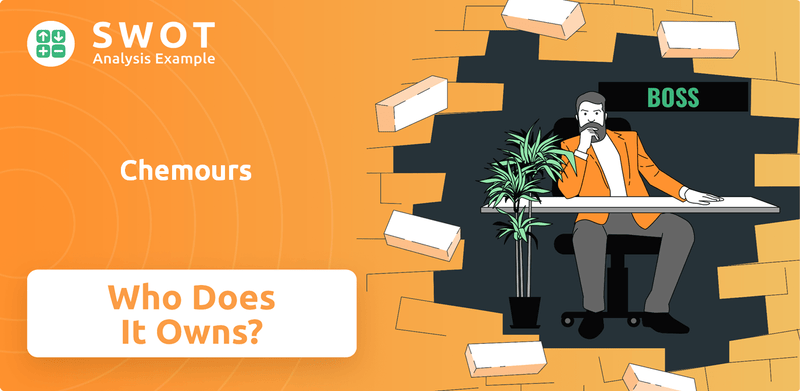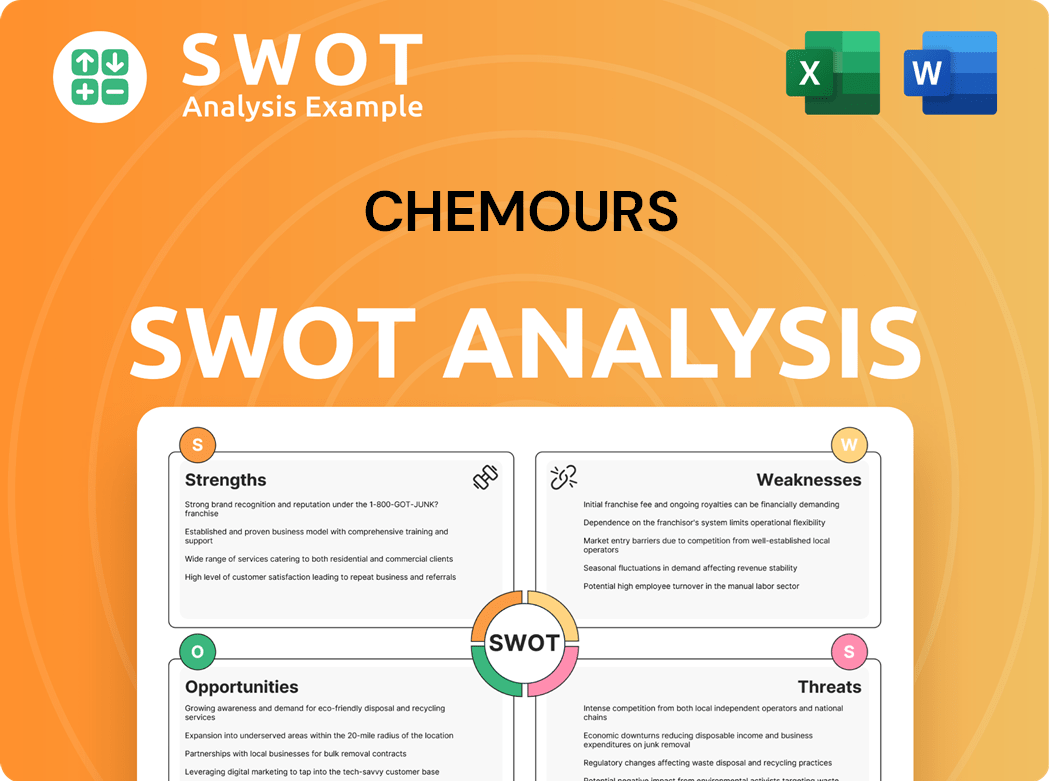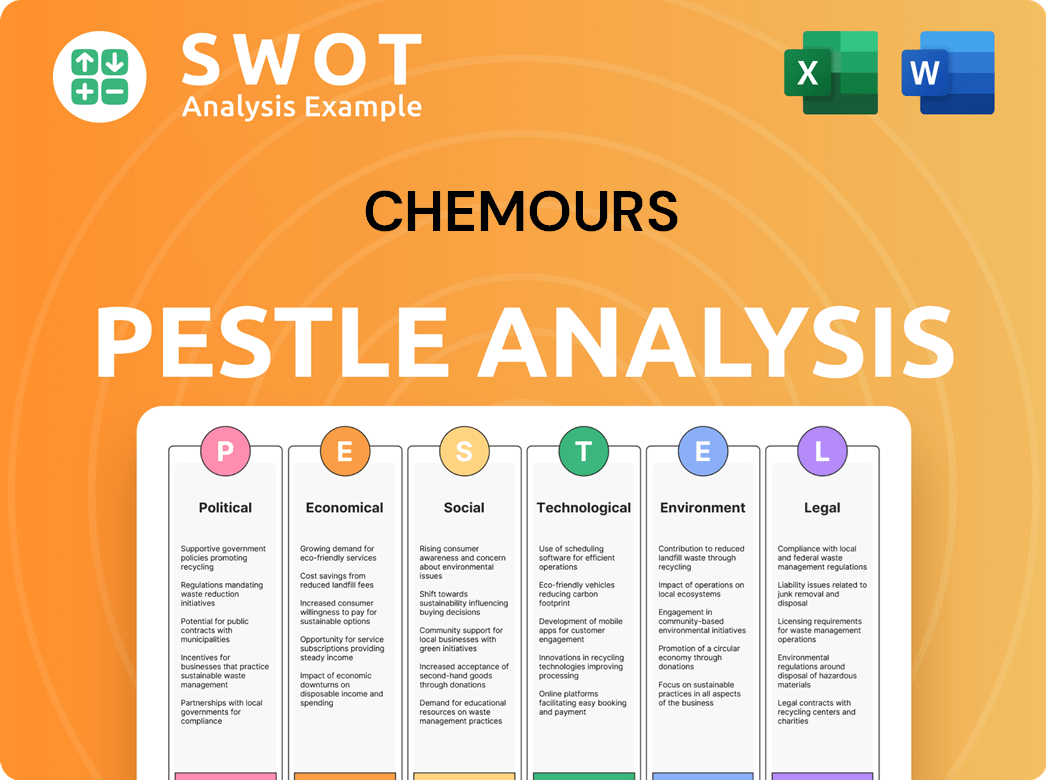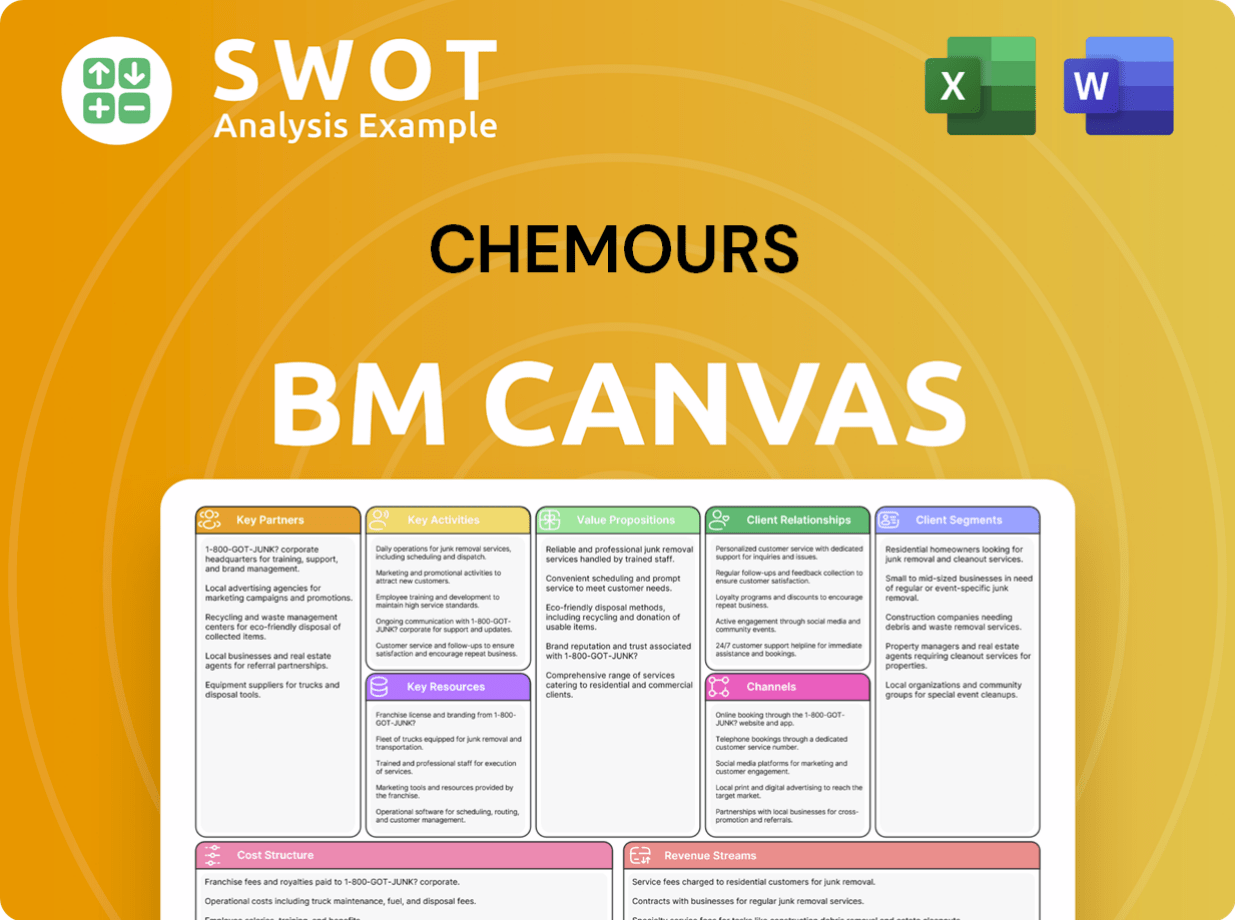Chemours Bundle
Who Really Controls Chemours?
Unraveling the ownership of The Chemours Company is key to understanding its trajectory in the competitive chemical industry. Spun off from DuPont in 2015, Chemours embarked on a new chapter as an independent, publicly traded entity. This shift dramatically reshaped its ownership, influencing its strategic decisions and market performance.

Understanding the Chemours SWOT Analysis is crucial, but first, let's explore the foundational question: Who owns Chemours? This exploration will dissect the Chemours company structure, examining the roles of major shareholders, the influence of Chemours executives, and the dynamics of Chemours stock ownership. We'll also uncover how Chemours's history, financial performance, and even its environmental impact are intertwined with its ownership profile, providing a comprehensive view of this significant player in the chemical sector.
Who Founded Chemours?
The story of Chemours Company ownership differs from that of most companies, as it wasn't created by entrepreneurs in the traditional sense. Instead, it emerged through a strategic spin-off from DuPont. This separation, announced in October 2013, led to Chemours becoming an independent, publicly traded entity in July 2015.
Initially, Chemours operated as a wholly-owned subsidiary of DuPont, managing its Performance Chemicals segment. This segment encompassed key areas like titanium technologies, fluoroproducts, and chemical solutions. The transition involved DuPont distributing all Chemours common stock to its existing shareholders, mirroring DuPont's shareholder base at the time of the spin-off. This corporate restructuring meant there were no initial angel investors or early backers beyond DuPont's existing investors.
The spin-off process was a significant undertaking, with Mark P. Vergnano appointed as President and CEO, and Mark E. Newman as Senior Vice President and CFO, establishing the leadership team. The separation agreement also addressed the transfer of certain historical environmental liabilities to Chemours, a factor that later led to legal challenges. Understanding this history is key to grasping the current Chemours Company ownership structure.
Chemours' initial ownership was a direct reflection of DuPont's shareholder base. This meant the initial investors were the existing shareholders of DuPont.
Mark P. Vergnano was appointed as President and CEO, with Mark E. Newman as Senior Vice President and CFO. This leadership team was crucial for the newly independent Chemours.
The separation agreement outlined the terms of the spin-off, including the transfer of certain historical environmental liabilities to Chemours.
Chemours became a publicly traded company in July 2015. This transition marked a new chapter for the company.
Chemours initially operated DuPont's Performance Chemicals segment, which included titanium technologies, fluoroproducts, and chemical solutions businesses.
The initial ownership structure was a result of a pro rata distribution of Chemours shares to DuPont shareholders.
Understanding the initial ownership structure is crucial for analyzing the evolution of the company. The Growth Strategy of Chemours highlights how the company has navigated its challenges and opportunities since its inception. As of late 2024, major institutional investors hold significant stakes in Chemours, reflecting the company's status as a publicly traded entity. The Chemours Company ownership has evolved over time, with fluctuations in shareholder composition due to market activities and strategic decisions.
The initial Chemours Company ownership stemmed from a spin-off from DuPont, with shares distributed to DuPont shareholders.
- Chemours was not founded by individual entrepreneurs but emerged from a corporate restructuring.
- The early investors were primarily the existing shareholders of DuPont.
- Mark P. Vergnano and Mark E. Newman were key figures in the initial leadership.
- The separation agreement included the transfer of environmental liabilities.
Chemours SWOT Analysis
- Complete SWOT Breakdown
- Fully Customizable
- Editable in Excel & Word
- Professional Formatting
- Investor-Ready Format

How Has Chemours’s Ownership Changed Over Time?
The Chemours Company's ownership structure has transformed significantly since its spin-off from DuPont on July 1, 2015. Initially, it was a wholly-owned subsidiary of DuPont. The separation marked the beginning of its journey as an independent, publicly traded entity listed on the New York Stock Exchange (NYSE: CC). This transition opened the door for a diverse ownership base, primarily comprising institutional investors, retail investors, and individual shareholders, shaping the company's trajectory and strategic decisions.
The evolution of Chemours' ownership reflects its growth and adaptation in the chemical industry. The initial public offering (IPO) allowed for the infusion of capital and the establishment of a market value, attracting various investors. Subsequent market activities, including stock purchases and sales, have further shaped the ownership landscape, making it a dynamic representation of investor confidence and market dynamics. Understanding who owns Chemours is crucial for anyone interested in the company's performance and future direction. The Growth Strategy of Chemours provides additional insights into its operations.
| Ownership Category | Percentage (Approximate) | Notes (as of May 2025) |
|---|---|---|
| Institutional Investors | 72.28% | Significant influence on decision-making. |
| Insiders (Executives & Directors) | 0.77% | Smaller percentage, but direct influence. |
| Public Companies/Individual Investors | 26.95% to 30.75% | Represents retail and other investors. |
As of June 2025, Chemours' market capitalization was approximately $1.59 billion. Major institutional shareholders include BlackRock, Inc., holding 14.5% of the shares, totaling 21,651,245 shares as of March 31, 2025, Vanguard Group Inc, and Fmr Llc. In 2024, the company reported net sales of $5.8 billion, a 5% decrease from the prior year, and net income of $86 million, a considerable improvement from a net loss of $238 million in 2023. The 'Pathway to Thrive' strategy, launched in 2024, is designed to boost shareholder value.
The ownership of Chemours Company is primarily held by institutional investors, with a smaller percentage owned by insiders and individual investors.
- Institutional investors hold a significant majority.
- Insiders have a smaller stake.
- The company's financial performance and strategic initiatives influence the ownership structure.
- Understanding the shareholders is key to analyzing the company's future.
Chemours PESTLE Analysis
- Covers All 6 PESTLE Categories
- No Research Needed – Save Hours of Work
- Built by Experts, Trusted by Consultants
- Instant Download, Ready to Use
- 100% Editable, Fully Customizable

Who Sits on Chemours’s Board?
The current Board of Directors of The Chemours Company oversees the company's strategic direction and represents its shareholders. The board's composition balances internal expertise with independent oversight. Joseph (Joe) Kava, a Google executive, joined the Board of Directors on January 3, 2025, bringing in external expertise. Denise Dignam serves as the President and CEO of Chemours. Details on which board members represent major shareholders or independent seats can be found in the company's proxy statements.
As a publicly traded company, Chemours operates under a one-share-one-vote structure, common for most public companies. This means that each common share typically carries one vote. There is no publicly available information about dual-class shares or special voting rights that would give specific individuals or entities outsized control. Understanding the Competitors Landscape of Chemours is also important when considering the company's position in the market.
Shareholders have sought to influence Chemours' governance. Recent demands for inspection of books and records highlight the importance of board accountability.
- Shareholder demands for investigation into executive compensation and accounting practices.
- Focus on remediating material weaknesses in internal controls.
- Full remediation of internal control weaknesses achieved by February 2025.
Chemours Business Model Canvas
- Complete 9-Block Business Model Canvas
- Effortlessly Communicate Your Business Strategy
- Investor-Ready BMC Format
- 100% Editable and Customizable
- Clear and Structured Layout

What Recent Changes Have Shaped Chemours’s Ownership Landscape?
Over the past few years, The Chemours Company's ownership structure has been shaped by strategic initiatives and financial performance. The company launched its 'Pathway to Thrive' strategy in 2024, which focuses on operational excellence and portfolio management to boost shareholder value. This has included cost-saving targets, with over $250 million in incremental run-rate cost savings aimed for by 2027.
Financial results have also influenced the company's trajectory. In 2024, net sales reached $5.8 billion, with a net income of $86 million, a marked improvement from a net loss in 2023. However, the first quarter of 2025 saw flat year-over-year net sales at $1.4 billion and a net loss of $4 million. The company's Adjusted EBITDA for 2024 was $786 million, with projections ranging from $825 million to $975 million for 2025, indicating a focus on maintaining financial stability and growth.
| Metric | 2024 | 2025 (Projected) |
|---|---|---|
| Net Sales | $5.8 billion | N/A |
| Net Income | $86 million | N/A |
| Adjusted EBITDA | $786 million | $825 million - $975 million |
The company's shareholder returns have seen adjustments, with a recent reduction in the quarterly dividend by 65% to $0.0825 per share. This decision, while impacting shareholders, is aimed at bolstering balance sheet flexibility and strategic investments. Institutional ownership remains significant, with major shareholders like BlackRock, Inc. and Vanguard Group Inc. influencing Chemours Company ownership and stock performance. As of March 31, 2025, the company had 150 million shares outstanding, reflecting ongoing market dynamics and strategic moves.
The major shareholders of Chemours include institutional investors like BlackRock and Vanguard. These large holders significantly influence the company's stock performance and strategic direction.
The company's stock has been affected by both financial results and strategic decisions. The reduction in dividends and the focus on cost savings reflect efforts to maintain financial health.
Recent developments include a $1.19 billion settlement related to PFAS contamination, impacting financial outlook and investor sentiment. Strategic partnerships are also emerging.
The company is focused on its 'Pathway to Thrive' strategy, aiming for cost savings and strategic growth. The projected Adjusted EBITDA for 2025 indicates a focus on financial stability.
Chemours Porter's Five Forces Analysis
- Covers All 5 Competitive Forces in Detail
- Structured for Consultants, Students, and Founders
- 100% Editable in Microsoft Word & Excel
- Instant Digital Download – Use Immediately
- Compatible with Mac & PC – Fully Unlocked

Related Blogs
- What are Mission Vision & Core Values of Chemours Company?
- What is Competitive Landscape of Chemours Company?
- What is Growth Strategy and Future Prospects of Chemours Company?
- How Does Chemours Company Work?
- What is Sales and Marketing Strategy of Chemours Company?
- What is Brief History of Chemours Company?
- What is Customer Demographics and Target Market of Chemours Company?
Disclaimer
All information, articles, and product details provided on this website are for general informational and educational purposes only. We do not claim any ownership over, nor do we intend to infringe upon, any trademarks, copyrights, logos, brand names, or other intellectual property mentioned or depicted on this site. Such intellectual property remains the property of its respective owners, and any references here are made solely for identification or informational purposes, without implying any affiliation, endorsement, or partnership.
We make no representations or warranties, express or implied, regarding the accuracy, completeness, or suitability of any content or products presented. Nothing on this website should be construed as legal, tax, investment, financial, medical, or other professional advice. In addition, no part of this site—including articles or product references—constitutes a solicitation, recommendation, endorsement, advertisement, or offer to buy or sell any securities, franchises, or other financial instruments, particularly in jurisdictions where such activity would be unlawful.
All content is of a general nature and may not address the specific circumstances of any individual or entity. It is not a substitute for professional advice or services. Any actions you take based on the information provided here are strictly at your own risk. You accept full responsibility for any decisions or outcomes arising from your use of this website and agree to release us from any liability in connection with your use of, or reliance upon, the content or products found herein.